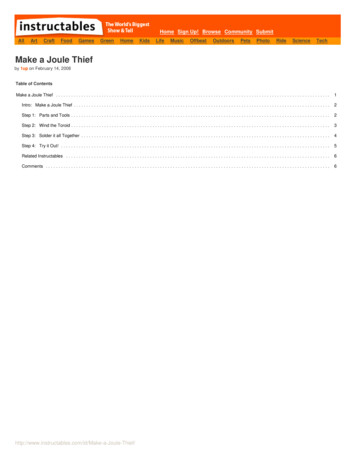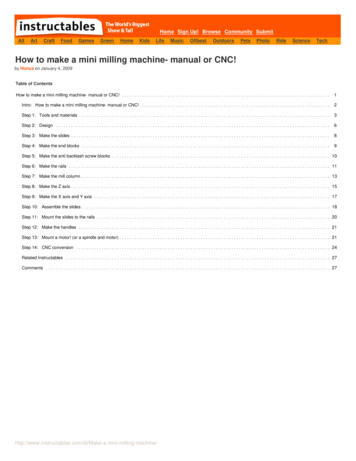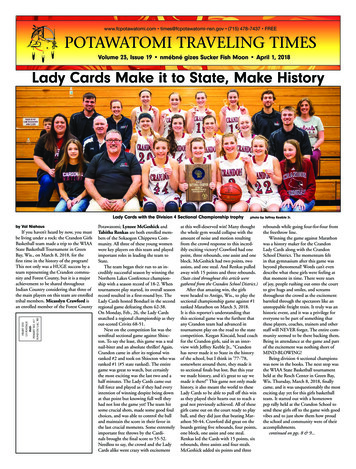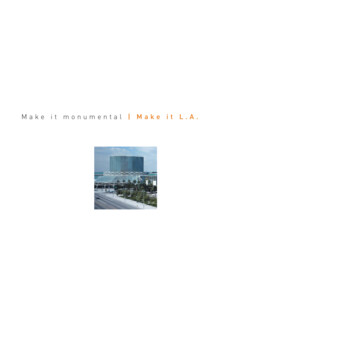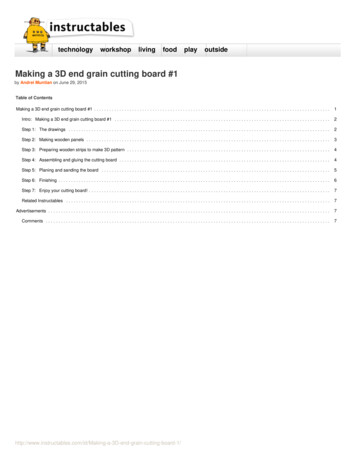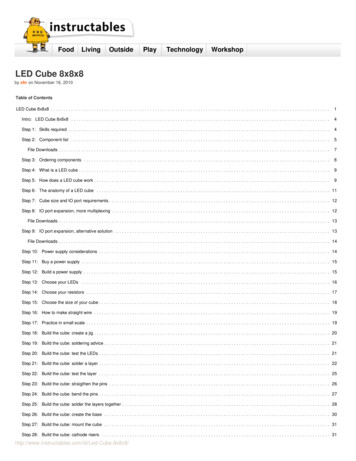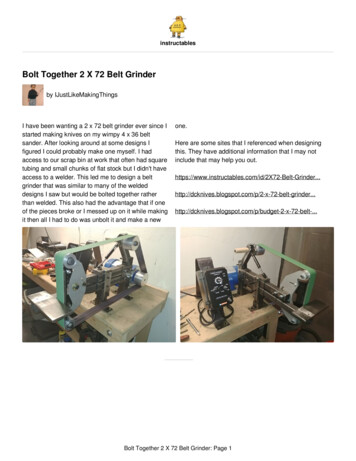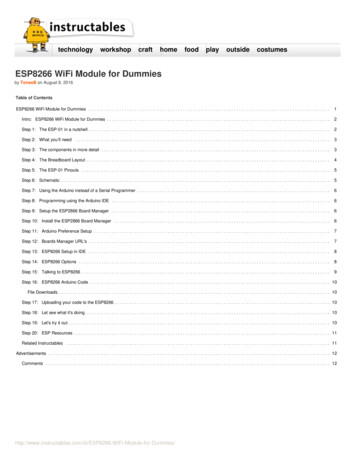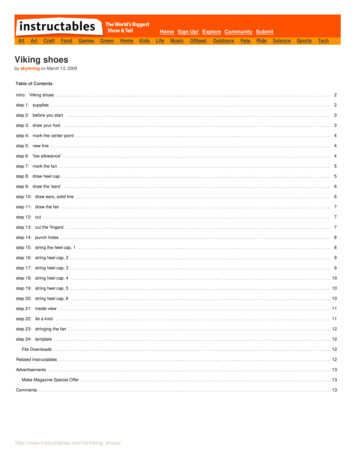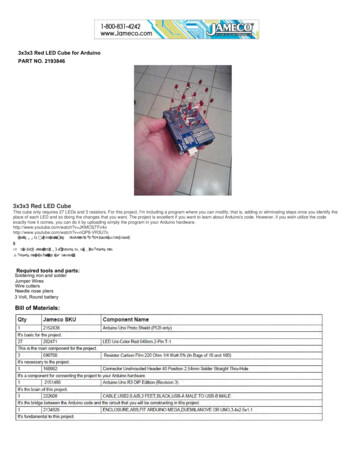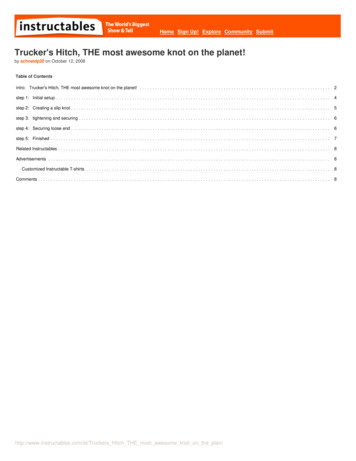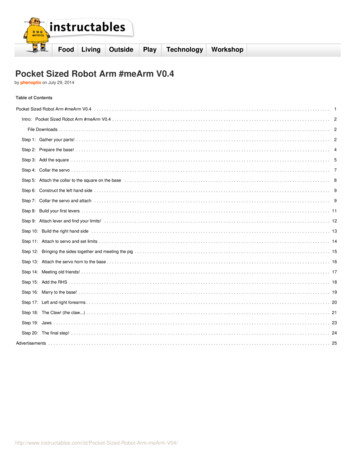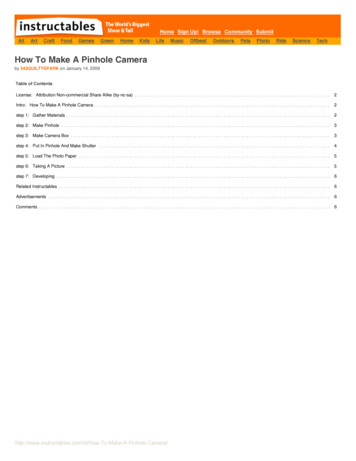
Transcription
Home Sign Up! Browse Community fbeatOutdoorsPetsPhotoRideScienceTechHow To Make A Pinhole Cameraby 343GUILTYSPARK on January 14, 2009Table of ContentsLicense: Attribution Non-commercial Share Alike (by-nc-sa) . . . . . . . . . . . . . . . . . . . . . . . . . . . . . . . . . . . . . . . . . . . . . . . . . . . . . . . . . . . . . . . . . . . . . . . . . . . . .2Intro: How To Make A Pinhole Camera . . . . . . . . . . . . . . . . . . . . . . . . . . . . . . . . . . . . . . . . . . . . . . . . . . . . . . . . . . . . . . . . . . . . . . . . . . . . . . . . . . . . . . . . . . . . .2step 1: Gather Materials . . . . . . . . . . . . . . . . . . . . . . . . . . . . . . . . . . . . . . . . . . . . . . . . . . . . . . . . . . . . . . . . . . . . . . . . . . . . . . . . . . . . . . . . . . . . . . . . . . . . . . . .2step 2: Make Pinhole . . . . . . . . . . . . . . . . . . . . . . . . . . . . . . . . . . . . . . . . . . . . . . . . . . . . . . . . . . . . . . . . . . . . . . . . . . . . . . . . . . . . . . . . . . . . . . . . . . . . . . . . . .3step 3: Make Camera Box . . . . . . . . . . . . . . . . . . . . . . . . . . . . . . . . . . . . . . . . . . . . . . . . . . . . . . . . . . . . . . . . . . . . . . . . . . . . . . . . . . . . . . . . . . . . . . . . . . . . . .3step 4: Put In Pinhole And Make Shutter . . . . . . . . . . . . . . . . . . . . . . . . . . . . . . . . . . . . . . . . . . . . . . . . . . . . . . . . . . . . . . . . . . . . . . . . . . . . . . . . . . . . . . . . . . .4step 5: Load The Photo Paper . . . . . . . . . . . . . . . . . . . . . . . . . . . . . . . . . . . . . . . . . . . . . . . . . . . . . . . . . . . . . . . . . . . . . . . . . . . . . . . . . . . . . . . . . . . . . . . . . . .5step 6: Taking A Picture . . . . . . . . . . . . . . . . . . . . . . . . . . . . . . . . . . . . . . . . . . . . . . . . . . . . . . . . . . . . . . . . . . . . . . . . . . . . . . . . . . . . . . . . . . . . . . . . . . . . . . . .5step 7: Developing . . . . . . . . . . . . . . . . . . . . . . . . . . . . . . . . . . . . . . . . . . . . . . . . . . . . . . . . . . . . . . . . . . . . . . . . . . . . . . . . . . . . . . . . . . . . . . . . . . . . . . . . . . . .6Related Instructables . . . . . . . . . . . . . . . . . . . . . . . . . . . . . . . . . . . . . . . . . . . . . . . . . . . . . . . . . . . . . . . . . . . . . . . . . . . . . . . . . . . . . . . . . . . . . . . . . . . . . . . . . . .6Advertisements . . . . . . . . . . . . . . . . . . . . . . . . . . . . . . . . . . . . . . . . . . . . . . . . . . . . . . . . . . . . . . . . . . . . . . . . . . . . . . . . . . . . . . . . . . . . . . . . . . . . . . . . . . . . . . .6Comments . . . . . . . . . . . . . . . . . . . . . . . . . . . . . . . . . . . . . . . . . . . . . . . . . . . . . . . . . . . . . . . . . . . . . . . . . . . . . . . . . . . . . . . . . . . . . . . . . . . . . . . . . . . . . . . . . . nhole-Camera/
License: Attribution Non-commercial Share Alike (by-nc-sa)Intro: How To Make A Pinhole CameraMake your own camera out of materials around the house and take black and white photos with it.step 1: Gather MaterialsYou will need a box, photo paper, thin piece of metal like a can or brass shim, tape, xacto knife, needle, and sand A-Pinhole-Camera/
step 2: Make PinholeThe pinhole is like the lens of the camera. Poke a tiny hole in the brass shim with a needle and sand it smooth. Trim the shim so there is a little space around the hole.step 3: Make Camera BoxYou can use a shoe box, oat meal box or whatever. The box must be light proof. When the lid is on and the shutter is closed the inside is completely dark. The only lightcomes through the pinhole. Make sure there are no holes or openings in the box. Seal it and paint it flat black. Cut a small square opening in the box for the pinhole to -Pinhole-Camera/
step 4: Put In Pinhole And Make ShutterTape the pinhole behind the square opening. I use electrical tape. Center the pinhole in the square. Then make the shutter which is just a flap that covers the pinholefrom the outside. It can be made from some more -Pinhole-Camera/
step 5: Load The Photo PaperThis must be done in complete darkness. You can make a darkroom in a bathroom or closet and use it for developing and changing paper. Tape a piece of photo paperto the inside of the box across from the hole. Put lid on and make sure the shutter is closed. Now you can go out in the light.step 6: Taking A PicturePoint the camera at what you want to shoot. It works best when it is bright and sunny. Depending on lighting and clouds hold shutter open for 30 seconds to 4 minutesthen close. Everything has to stay perfectly still. Go back to the dark room and take paper out to e-A-Pinhole-Camera/
step 7: DevelopingYou will need developer, fixer, water, tongs, towels, and a safe light in you dark room. It must be pitch black when safe light is off. I found out you can use orange LEDhalloween lights as a safe light. It is cheaper and you get more light than a small red darkroom bulb. The paper from the box will be a negative to make the positive putanother piece of photo paper under the developed negative face to face. The negative must be on top. Use a piece of glass to press them together and turn the lights onfor a few seconds. Make sure your extra photo paper is safe and covered or it will all develop black. Now develop the positive. It goes in the developer then water thenfixer then water then air dry.Related InstructablesIndustrialphotography hasty mistakes;Blasting GritRecycler by inadPhotographyTip: TakingBeautifulPhotos AndEditing Them byShadow DragonHow to make aslide to take 3Dphotos with a2D Camera bytominsouthflMacroPhotography:An EssentialSkill for GoodInstructables by1upHow to takeBetter Pictureswith a CameraPhone byultrauberPinhole DSLR(quick and dirtyedition) byCYNICALiforniaTime-LapsePhotography byrandofoHow to make apinhole cameraout of an oldpoint n' shootby ablisspirateAdvertisementsComments50 comments Add Commentsaharahoveybaldwin says:view all 51 commentsJun 7, 2010. 1:08 PM REPLYcan i use a safelight for this step? like, while loading the paper.92033 says:Jun 6, 2010. 7:50 PM REPLYLook up my postings on the other 'Making a Pinhole Camera' pages. Also, to everyone of your questions.simply go to your local camera photo shop dealer.They have everything you need for developing film and prints, printing papers to use, information, etc. Just visited your page.great photos. You can makean easy tripod base for use on the camera. Use a piece of 1/4" thick plywood or plastic. Drill a 1/4 inch hole in the center. Use double-face carpet tape orlayer of rubber cement on face of the wood/plastic base and layer on bottom of camera. Stick together for a permanent bond. Screw your tripos screw intothe hole and you're all set. Want 'simpler'? Lightly duct-tape it to tripod. Removes easily. Idea is to hold the camera still and level.this'll do the trick. GreatInstructable mind-refresher for me.have been in photography all my lifetime.'1200 Year Old Highlander Immortal', y'know. :-) Which reminds me.Do youknow what Jesus said to the Apostles at The Last Supper? "All you guys who want your picture taken, sit on this side of the table with Me". Moses was TheFirst Photographer. He used a Pinhole Camera and Bolt Of Lightning for the FLASH. Came out pretty good, eh?KMaq says:Feb 11, 2010. 10:30 PM REPLYi got photo paper from staples. will this work? it comes in a small box of 100. i suppose i need to take them out of the package in the dark room as -Pinhole-Camera/
Musicman41 says:Jun 6, 2010. 5:30 PM REPLYYou need to make sure that it is photo DEVELOPING paper. What it sounds like you got was photo PRINTING paper. They are not the same thing.Developing paper is sensitive to light and changes color when exposed to the light. Printing paper is not and can only be colored by ink. I hope this helps.vickaronomie says:Apr 13, 2010. 10:52 AM REPLYYes, or else the paper will be developed all over, turn gray, and will not be able take another image. It'll be useless, like film taken out of the cartridgeand exposed to sunlight.MOYERsamuel says:Jun 5, 2010. 5:22 AM REPLYwhat is a pinhole camera for ?oobtim says:Jun 4, 2010. 12:15 PM REPLYI've been developing at home for years in shared houses too. I've used a dark cupboard, in the attic or thick blankets across a bathroom window in the pastand have been used with good results (mostly in the evening/night to be safe). A red light is needed if you want to see what your doing though. :)Look on any retrophotographic site or pick up and old photography book from a second hand book store to find the details of development and thechemicals. Ebay is a good source of cheap photography equipment too.Good luck!lrdogs12 says:May 2, 2010. 6:36 AM REPLYNetPrintz specializes in professional quality e6 slide film processing and developing as well as bulk slide scanning. We monitor chemistry and equipmentdaily and only professionals get near your originals. http://netprintz.net/scans.html or http://www.netprintz.net/e6.html to go directly to the pricing page.NetPrintz is competitively priced and will produce the highest quality output for you every time. We use plastic mounts and they are shipped to you in aplastic box. We are a full service lab producing 30” Chromira print posters, copy work, scanning to cd and photo restoration.likeanita says:Feb 24, 2010. 7:58 PM REPLYcan u be more specifite about how to develop a pic, by using photo paper? becasue it seems interesting to just directly have a image on the photo paperinstead the filmvickaronomie says:Apr 13, 2010. 10:50 AM REPLYThe photo paper you use is a special paper with silver crystals. THIS PAPER: Resin-CoatedVariable-Contrast is what you need. You also need the developer--which is on that website--which is for PAPER development, not film, because they'redifferent. :PIt's all done in a darkroom because, like film, the image initially imprinted onto the paper will be destroyed if left in direct light of any kind. There are filtersused over dim lights to prevent that.Other than that, the chemicals used and process is pretty much the same as developing film; developer, stop bath, fixer, and then a wash through somefresh water, to remove all the chemicals. If the wash isn't done, then the chemical stains will eat the photo.Just research it. You need a lot of stuff, if you aren't taking a photography course in college, like I am. The darkroom and everything inside it is availableto me, but an average Joe might have to make their spare bathroom into a darkroom, in order to be able to develop photos. ;)nutsandbolts 64 says:Feb 21, 2010. 5:33 AM REPLYwhere do you get the developer and fixer?BUddy ca111 says:Sep 9, 2009. 7:30 PM REPLYWhy does everthing have to be perfectly still?Puppy-Sized-Elephant says:Feb 18, 2010. 3:58 PM REPLYthe picture would be blury, like when you take picture and your hand moves slightly, so it turns out a bit blurry, when the shutter is open taking a longexposure picture, its just like that shaky hand, but on a larger scale, if you can understand what i meankimm123 says:Sep 10, 2009. 4:33 PM REPLYthe picture will come out blurry and not right, i suppose XDanti mullet9 says:It needs to be darkroom paper and not regular inkjet photo paper for a printer.Something like this will totally d-Glossy/dp/B00009V3C5/ref pd cp p hole-Camera/Feb 15, 2010. 10:46 AM REPLY
Gh{O}sT says:Feb 5, 2010. 11:37 PM REPLYThx gonna use it for photography project at school (i will credit you)sxdemon says:Jan 18, 2010. 4:08 PM REPLYI build something similar, but I was using a len instead of only a pinhole.Lamah says:Nov 1, 2009. 2:54 PM REPLYwhere does the digital camera goYerboogieman says:Nov 7, 2009. 7:47 PM REPLYYou don't need it when you build this. Just like you don't need a digital camera when you are using a 35mm camera.Dr. Steel says:Jan 9, 2010. 7:30 PM REPLYI do believe that was a troll.darelite says:Dec 27, 2009. 11:21 AM REPLYhheeyyyy what about fixer?linkmaster03 says:Feb 14, 2009. 7:56 PM REPLYWhat do you mean by "photo paper"? What kind of photo paper?Yerboogieman says:Nov 7, 2009. 7:48 PM REPLYLight sensitive paper.kentdunne says:Jun 1, 2009. 2:54 PM REPLYIt's a specific type of paper. It's got a coating of light sensitive stuff (basically a cocktail of Emulsion, little silver-halide crystals, and some other thingsspread across it). It's not just "photo quality" paper that you might buy at Best Buy (but it's very easy to think that now adays ])You probably have to order it online-- I get mine at www.freestylephoto.biz343GUILTYSPARK says:Feb 17, 2009. 5:59 PM REPLYLight sensitive paper. Parts that were exposed to light will turn dark when developed.Yerboogieman says:Apr 3, 2009. 9:26 PM REPLYThis one kid at school decided to turn on the lights in the dark room and ruined hundreds of dollars of photo paper.foxtrot4697 says:Jan 2, 2010. 8:42 PM REPLYWHY DO THEY HAVE LIGHTS IN THE DARk room?Yerboogieman says:Jan 3, 2010. 10:59 AM REPLYWHY ARE YOU YELLING?!They have lights for when she is teaching how to set stuff up.lost2010 says:Apr 17, 2009. 9:58 PM REPLYlove it when that happens sorry but i think hundreds of dollars is more like 10 or 15 unless you guys were dumnb enough just to take ur paper outand lay it everywhere instead of using 1 piece at a timchilly9781 says:How much do all the materials generally cost (chemicals and photo paper)?And this is great! I might get into this so thanks for the ke-A-Pinhole-Camera/Nov 7, 2009. 7:39 PM REPLY
mtownsend says:Jan 18, 2009. 10:54 AM REPLYAm I the only one who thought this meant a tiny little spy camera? I feel so uncultured when I'm on this site.a.nony.mouse says:Oct 2, 2009. 12:11 PM REPLYI was thinking the exact same thing, but this is cool, too :)sweetnienna says:Oct 1, 2009. 12:49 PM REPLYwhy did you use a little piece of metal for the hole ?Great instructable by the way, thank you for sharingsuperpat182 says:Sep 9, 2009. 9:12 AM REPLYdeveloper is a chemical that washes the silver particles off a piece of photo paper or film, so the image comes through. it develops the picture. if you wantto pick some up i suggest B&Hphoto.com they got what you need, just dearch developerlivvyf says:Jul 17, 2009. 9:09 AM REPLYwhat do you mean by "developer"? what does it look like?michaelchapala says:Apr 26, 2009. 9:40 AM REPLYVery informative and practical.airhead12 says:Jan 14, 2009. 6:33 PM REPLYman i was just fixing to post a pinhole camera instructable! come to think of it every time i get one in my head or even ready it happens. then everyone willsay oh this is so&so's idea.thepelton says:Feb 16, 2009. 11:17 PM REPLYI know how you feel. I was looking to see what I could post as an instructable, and found several ideas already published here.ac1D says:Jan 14, 2009. 8:10 PM ttle-Mac-Pinhole-Camera/airhead12 says:Jan 15, 2009. 6:01 PM REPLYi have not noticed that before. thanks though looks like somin to do. ive had that happen to me about ten other times though.fultron89 says:Jan 14, 2009. 8:25 PM REPLYVery cool. I am constantly amazed that making a camera like this is so easy. Note: I read an article about a guy who, instead of developing the photos withchemicals, simply put the negative on his scanner and inverted the image with photoshop or whatever. Pretty cool.thepelton says:Feb 14, 2009. 7:26 PM REPLYI have used inversion to see who or what was in a negative. Neat process. I used Corel draw.Uncle Kudzu says:Feb 13, 2009. 9:17 PM REPLYthanks - reversing the negative image with a scanner is a great idea! that would sure save a step in a wet darkroom.bustedit says:Jan 15, 2009. 9:14 AM REPLYGood ible, cool results, but you are a lil vague in spots. Is there a box size that best suits this? for instance, is the distance from pinhole to paper important?and by sanding the metal shim, is the purpose to make the pinhole more round, or to rough up the shim surface?Kiteman says:Jan 15, 2009. 3:24 PM REPLYIncreasing the distance from hole to paper makes the image larger, but you need a longer exposure time. Sanding the shim makes sure that there are nobits of bent metal obstructing the light - odd-shaped holes give distorted images.fishhead455 says:Kiteman--Yes, distance makes a difference in that case: More distance larger exposed area.more -Pinhole-Camera/Jan 16, 2009. 10:03 AM REPLY
fishhead455 says:Jan 16, 2009. 9:56 AM REPLYFLATULATIONS-- Try this: Use color paper . It is designed to give the opposite color when exposed to light passed through the negative. The result will bereality in reverse-color. I use a simple changing bag to load/unload the camera and place the exposed paper back into its original paper package and boxwhile still in the changing bag. Gotta take it to a local developer .or have the color equipment at home. Reality in reverse.KEWEL FER SHER Greatible.ciao I use an oatmeal box, tin foil, sewing needle to make the pin-hole. distance of paper from the hole does not make a difference. The depth of field isinfinity, (everything is in focus). Ambient temperature will make a difference: colder is slower.Weissensteinburg says:Jan 14, 2009. 7:03 PM REPLYLooks like you're getting pretty good results. We used to put two pieces of cardboard on either side of the paper to hold it there.rimar2000 says:Jan 14, 2009. 6:03 PM REPLYGreat job, really.Capt. Fat says:Jan 14, 2009. 5:59 PM REPLYIf you can make that with stuff like that. KEEP UP THE WORK!!!!!!!!!!!!!! GENIOUS. And for the record. Capt. Fat was hereview all 51 e-A-Pinhole-Camera/
Related Instructables Industrial photography - hasty mistakes; Blasting Grit Recycler by inad Photography Tip: Taking Beautiful Photos And Editing Them by Shadow Dragon How to make a slide to take 3D photos with a 2D Camera by tominsouthfl Macro Photography: An Essential Skill for Good Instructabl
